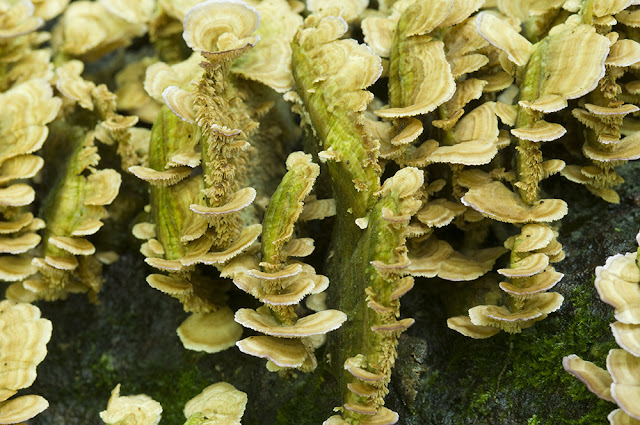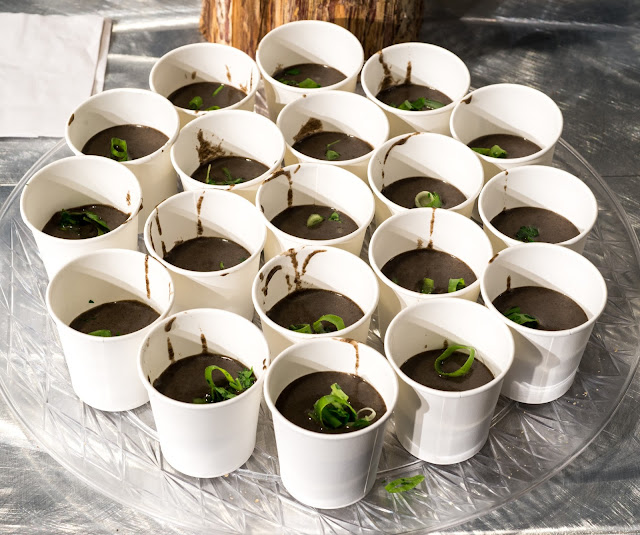Last weekend our mushroom club, Connecticut Valley Mycological Society, was honored to host the 39th Annual Sam Ristich Foray, held by the member mushroom clubs of the Northeast Mycological Federation. Our location was Connecticut College, in New London, Connecticut, allowing us to share the forests and parks of southeastern Connecticut that we are very familiar with. The four-day conference featured organized forays, classes on mushroom dying, medicinal mushrooms, microscopy, taxonomic name changes, and toxic mushrooms. We were honored to have as a instructors and identifying mycologists Alan and Arleen Besette, Gary Lincoff, Rick Van de Poll, Dorothy Smullen, Walt Sturgeon, Renee LeBeuf, Roz Lowen, Jason Karakehian, Jon Plischke, Sue Hopkins, Dianna Smith, Rod Tulloss, Alison Birks, Ed Mena, and Bill Yule.
Mycophagy is the cooking and eating of mushrooms for pleasure, and in
our case along with a large amount of mushroom hunters, we cook wild
mushrooms. Robert and I, along with a few very dedicated and skilled volunteers, cooked up the mycophagy for 190 people on Friday night. Most of the recipes we used are our own, original recipes, while others like the Black Trumpet Soup Shooters were made as we went along, starting from a general idea of what we wanted and tasting as we went along.
Maitake Jerky, made with donated hens (Grifola frondosa) from several CVMS members last fall, as we were not able to find very many ourselves. After the jerky was made last fall, we vacuum packed it to last over the winter, and then portioned it out into small, waxed bags to enjoy as a snack.
Black Trumpet Soup Shooters were served warm in paper espresso cups. It was a lovely, smooth soup made with fresh black trumpets (Craterellus fallax), celery, onions, potatoes, and thyme, with just a touch of cream and a parsley/scallion garnish.
Black Trumpet Choux filled with Black Trumpet Cream Cheese is one of my favorites. The choux pastries were made with dehydrated black trumpets (Craterellus fallax) collected last year while attending the NEMF foray in Maine.We collected many pounds of trumpets; luckily we traveled to the foray with dehydrators and brought home several gallons of dried mushrooms which are powdered for this recipe. The cream cheese filling is made with fresh, sauteed black trumpets and chopped scallions.
Our bolete season is very unpredictable, so bought some West Coast boletes (Boletus regius) from a forager in Oregon to make into these Porcini Polenta Cubes. I rehydrated the dried porcini in vegetable broth before sauteing them butter, then added it all back into the cooked polenta along with Parmesan cheese and fresh parsley.
These are Hen Duchesse Potatoes, a fun appetizer I make often to use up all the little bits and pieces left over when cleaning hens (Grifola frondosa) to make jerky. The hen bits are finely chopped in the food processor with some onion before being browned and oven roasted, then added to mashed potatoes with a bit of egg and seasoning. I pipe them into small cupcake papers and cook them until nicely browned.
Morel and Ramps Greens Biscuits were made from morels (Morchella americana) we collected last spring and ramps greens that we collected and froze from this spring. I had extra rehydrated and sauteed morels, so I blended them into butter to spread onto the biscuits.
Thai King Oyster Skewers are made from a full, 11 pound case of king oysters (Pleurotus eryngii) from the local Asian market. The stems are sliced into discs about 1/4" thick, then sauteed until browned before being poached in a tom-ka broth until the broth reduces. Prepared this way, the mushrooms take on a similar texture as scallops with a Thai-flavored coating of tom-ka.
"Chicken" Sausage Toasts with
Garlic Mustard-Mustard and
Pickled Ramps uses 3 of our recipes. We stacked the crisped chicken (Laetiporus sulphureus) sausage slices on toasted baguettes with a smear of the spicy mustard (Alliaria petiolata) and a sweet/sour garnish of ramps (Allium tricoccum) pickle.
And for our mushroom dessert, we served
Chaga Tapioca Pudding garnished with some beach plum fruit leather wedges. First we make Chaga Frappe (Inonotus obliquus) with some coconut milk and maple syrup, then we cook the frappe into a tapioca pudding. Guests were able to add a bit of whipped cream if desired.
 |
| The full, double sided table of mushroom goodies |























